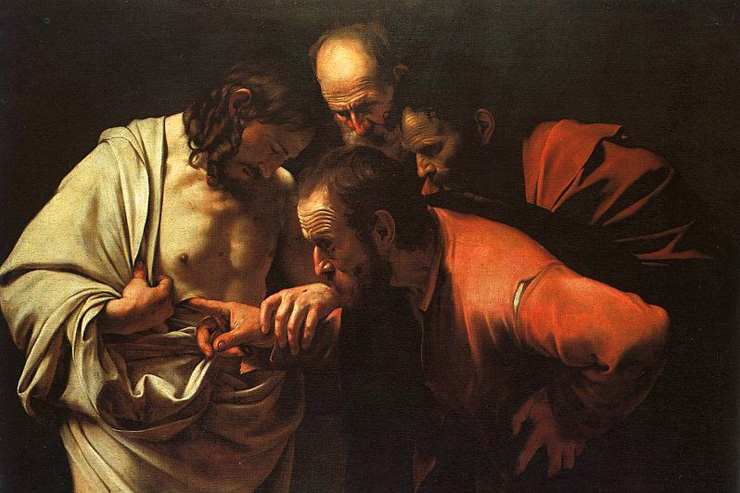The Hope of Christ’s Wounds
by Joannie Watson | April 1, 2016 12:04 am
 [1]
[1]“The Incredulity of Saint Thomas” (detail) by Caravaggio
Everyone should have to answer the theological questions of five-year-olds at least once or twice in their lives. It’s incredible what their innocent perceptivity will lead them to ask… and leave you to try to explain!
My nephew Sammy: “Joannie, where is God?”
Me: “He’s everywhere, Sammy.”
Sammy: Long pause. Looks up at the ceiling. “Even in that vent up there?”
During my family’s recent Easter visit, we began our Good Friday by watching a movie about the life of the Blessed Mother. Sammy’s questions added, rather than detracted, from my viewing experience. Attempting to answer his questions made me meditate on things I had begun to take for granted. Particularly heart-wrenching was when he asked me why the other two men were being crucified next to Jesus. When I responded that they were robbers, he exclaimed, “But Jesus isn’t a thief! Jesus didn’t do anything wrong!” If only we all felt the same righteous indignation when we read the now-too-familiar Gospel story.
But it was another question that really gave me fruit for meditation for the rest of the weekend. The Passion scenes were bloody without being graphic, and Sam looked up at me inquisitively. You could tell his mind was racing. “Did God give Jesus new skin?”
The question immediately brought Carvaggio’s masterpiece, The Incredulity of Saint Thomas to mind as I answered him. Of course, I gave him a simple response. But I couldn’t stop thinking about the real profundity of the answer. Jesus bore the wounds of the Crucifixion even in his resurrected flesh. Why?
The wounds of Christ are the only man-made things in heaven. Christ doesn’t take them away, nor does he hide them from us. They are the signs of our salvation. They are the signs of his love for us, the extent he will go to win us back, and our unworthiness to receive that love.
The wounds of Christ are the wounds of love and mercy. Pope Francis called them “light-filled openings.” It is as if they are windows, through which we see the love of God, and through which God gazes on us. As we read in Sister Faustina’s diary, we ask that the Father look upon poor souls only through the wounds of the Son. (Diary, 1227) If he looks at us through the wounds of his Son, he will be to us not a judge, but a merciful Father.
But it’s not just the flesh of the Son that is transformed rather than replaced. At the Final Judgment, when our bodies are raised and reunited with our souls, we will not receive new bodies. We will receive back our own earthly bodies. Our bodies are good, though they are affected by the Fall. Death, the separation of the soul from the body, is unnatural. It is an effect of the Fall and not originally part of God’s plan. At the Second Coming, God’s creation will be made whole again, and at the resurrection of the body, we receive back our bodies—those good created gifts of God—resurrected and transformed. Not replaced.
Christ took on our human flesh, becoming incarnate, to save our human flesh. We are not souls trapped in bodies, but human persons, beings “at once, corporeal and spiritual” (CCC 362). If we believed our human body wasn’t worth saving, or that our human bodies would just be replaced one day, we wouldn’t be that far from the ancient Manichean heresy that believed material world was evil.
Did God give Jesus new skin? No, the effects of the Crucifixion are there for us to see. We look upon him whom we have pierced, but now we look at the wounds in resurrected flesh. Is there a greater sign of hope? Look at what we have done to our God! But as we do that, we simultaneously look also at what He has done for us. In gazing upon the effects of our sin—his wounds—we are also gazing upon the effects of his goodness—the resurrection.
When we feel the marks of the nails, we are not only touching the result of our transgressions, we are touching the promise of our own future glory.
- [Image]: http://www.integratedcatholiclife.org/wp-content/uploads/caravaggio-st-thomas-detail-featured-w740x493.jpg
Source URL: https://integratedcatholiclife.org/2016/04/watson-the-hope-of-christs-wounds/